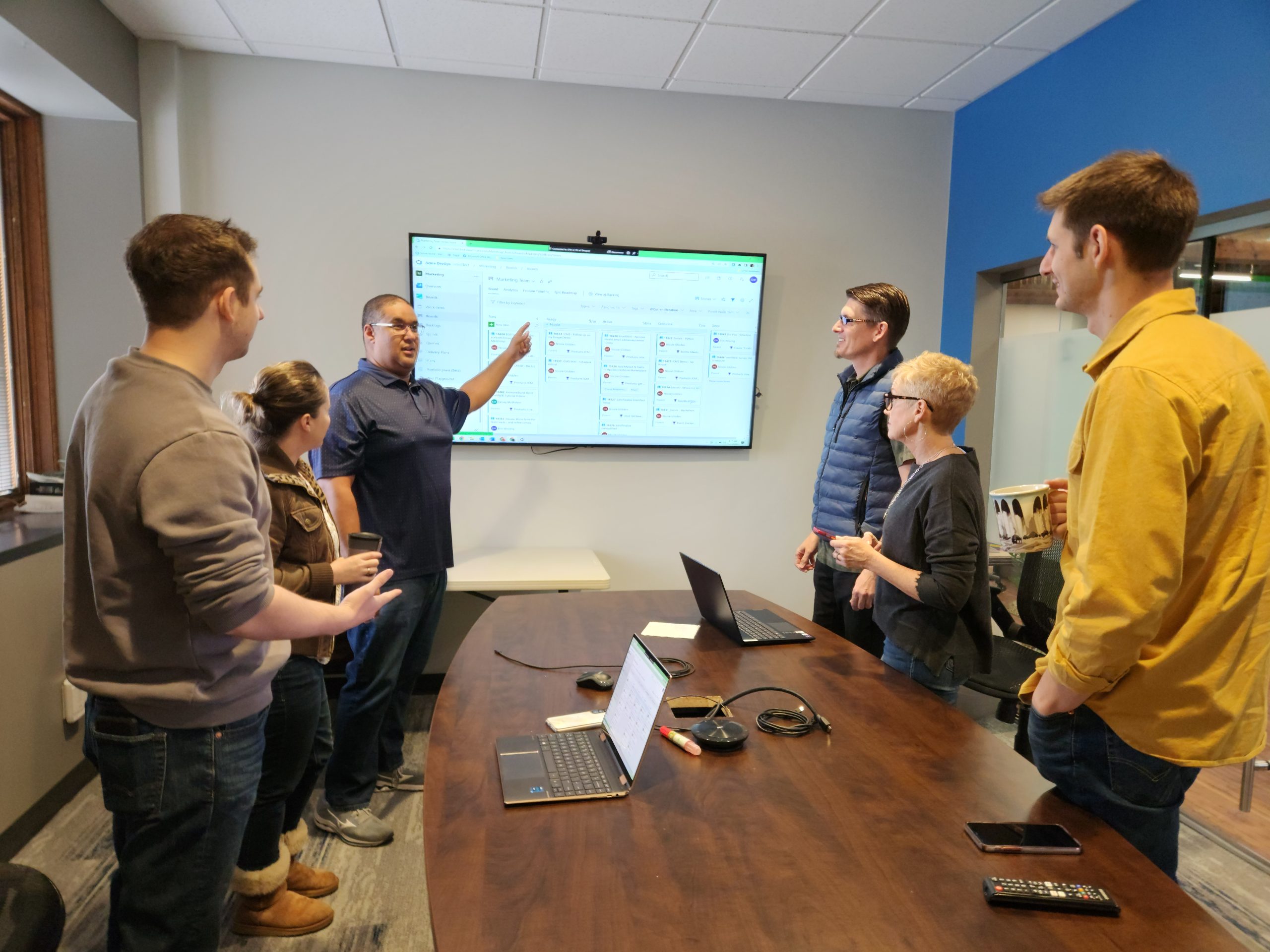Your Beginner’s Guide to Agile Development and Scrum
Do you nod along when someone talks about a retrospective, stand up, or user story, pretending to know what they’re talking about? Or maybe, you’re currently on a Scrum team and don’t want to ask the obvious questions? Well, then, this article is for you! It will cover all the basics of Scrum and address the most frequently asked questions by those considering a switch to Agile.
As a Project Architect who has also served as Scrum Master on agile software development teams, I have guided many clients through multi-product integrated releases and deployments in diverse industries. I love working on Agile teams and have worn many hats, including Scrum Master and Product Owner. It’s okay if you don’t know all the project management jargon yet—it’s constantly evolving, and Scrum is no exception. But rest assured, the concept is quite simple.
“DevOps,” “Scrum,” and “Agile” are common project management buzzwords for today’s team, displaying a new iteration of the software development team’s decades-long evolution in creating and following best practices.
Scrum aims to bring your product to market faster with a happier, less-stressed team. Who wouldn’t want that?
What is Scrum?
First of all, Scrum isn’t an acronym. It is just called Scrum, and it’s an agile framework.
Not sure what agile is? Wonder no more. There are two primary ways to run software projects.
- Waterfall projects aim to complete an entire project by a specific deadline. Everything is interconnected. And if not completed on time, there is typically no product.
- Agile projects are by far the most popular these days. An agile project aims to bring the Minimum Viable Product (MVP) to market as quickly as possible. What is needed to get the smallest version of the product in front of users? A Scrum team works on completing that first; then, they work on adding additional features to it as time allows.
Scrum is one of several types of agile frameworks for developing and delivering complex projects. If needed, Scrum adapts, and as such, roles and responsibilities may change throughout the life of a project. Agile means that the development team is flexible in its approach to delivering value quickly.
The Agile manifesto provides more details on the importance of flexibility. Within an agile development team, it’s vital not to lock into contracts and processes and instead focus on creating working software collaboratively.

What are the Roles and Responsibilities of a Scrum Team?
The responsibilities outlined below are defined for the start of the project but may change over time. When changes occur, it is critical to communicate them to all team members.
Product Owner
- Develops and maintains the Product Backlog Items (“user stories”), prioritizes them, and organizes them into releases.
- Works with the Development Team and Scrum Master to create Product Backlog Items that are independent and can be estimated by the Development Team.
- Is readily available to work with members of the Development Team to answer questions, clarify item descriptions and acceptance criteria, and test delivered items.
- Acts as Team representative for Product Stakeholders’ interests. This includes product functionality, ensuring timely value delivery, prioritization, and defining product releases and acceptance criteria.
Scrum Master
- Team representative to Product Stakeholders for project status, budget, team resources, and capacity.
- Works with the Product Owner to ensure the Product Backlog is appropriately managed, maintained, and understood by the Development Team.
- Schedules and facilitates sprint review meetings and daily standups.
- Removes or facilitates the removal of any obstacles faced by the Development Team.
- Ensures the Development Team has the capacity, skills, and experience to be successful.
Development Team
- Work with the Product Owner and Scrum Master to build and deliver completed Product Backlog Items.
- Estimate and commit to Product Backlog Items for a given sprint.
- Identify obstacles and either remove them or raise them to the Scrum Master.
- Team members include all individuals with the various skills required to deliver the project.
By combining all the individuals needed onto a team that has clear guidelines, structure, buy-in, and one united goal, Scrum teams often have a more positive team culture.
Who Owns Quality in a Scrum Team?
Everyone does! This is key and crucial to Scrum. There isn’t a “QA” or a “Dev Only” person. Everyone commits to completing work each sprint, including ensuring that they achieve the Definition of Done (DoD). That DoD means that when the team finishes a story, it’s already been pre-agreed with the product owner what ‘done’ means, including performance and quality metrics.
What do Meetings Look like Under Scrum?
Scrum has only four proscribed ceremonies (types of meetings).
- Daily Scrum – Each day, the team meets for about 15 minutes and discusses what they did yesterday, what they plan to do today, and if they have any roadblocks or obstacles to overcome.
- Sprint Retrospective – At the end of each sprint, the team talks about what went well and what can improve. These items are fed into the Scrum process so that constant improvement occurs. The team owns the responsibility to improve itself and its processes.
- Sprint Planning – At the beginning of each sprint, the team looks at the prioritized list of work from the product owner and agrees on how much they can agree to deliver for that sprint. The Team members and product owner negotiate (mediated by the scrum master), then the team agrees on a list of items that become the work that will be done in the sprint. It should be a rare thing to add work to a sprint after this meeting.
- Sprint Review – The team presents the sprint’s completed work to the product owner/stakeholders at the end of each sprint. Feedback is immediate. As a result, the team and stakeholders stay on the same page and have an opportunity to celebrate the team’s success.
In each sprint, team members deliver an increment of work collected as backlog items, accepted by the product owner, and put into service for the stakeholders.
Agile Development at IntelliTect
For an organization to be agile, it must be able to adapt to business changes in real-time. You press toward a minimal viable product (MVP) with IntelliTect agile projects. This is the simplest part of your application that gives your business value. This approach allows you to get an ROI and adjust courses based on real-world user feedback.
From here, we will continue to build new features to complete the project.
You might find that as you develop your app, your users attempt to operate it in a way you didn’t consider. With agile development, you can change the primary objective or the destination whenever it makes sense to your business needs.
Our agile process relies on flexibility and leverages a process framework to help deliver consistently excellent results. Your passion for the business space and our passion for software development create a high-performance environment that forges great products and long-lasting relationships.
Want More?
Check out software engineer Casey’s article Scrum Master Check-In: The Sprint to learn more about what it takes to succeed as a Scrum Master.
Ready to dive into an agile project with IntelliTect? Let’s chat!

Does Your Organization Need a Custom Solution?
Let’s chat about how we can help you achieve excellence on your next project!
